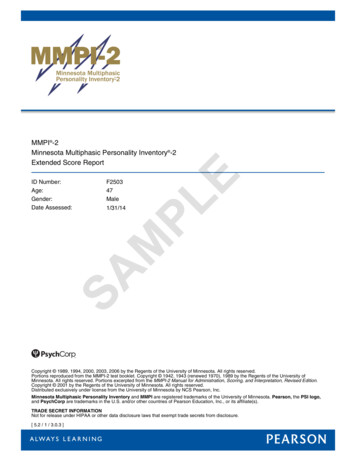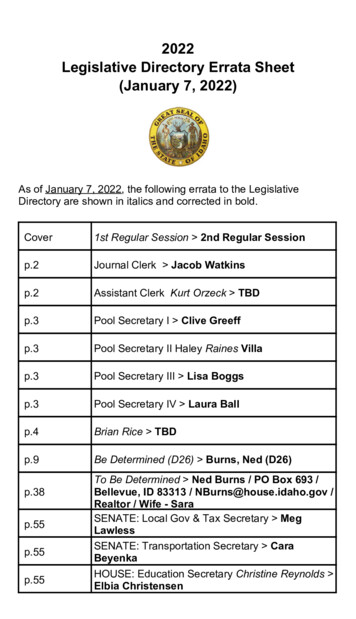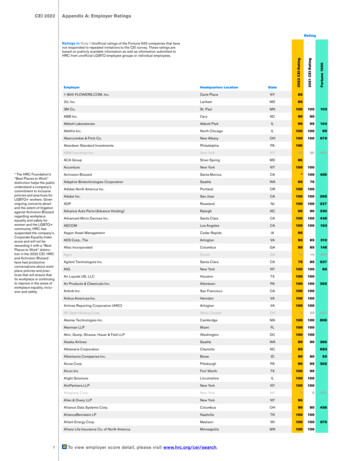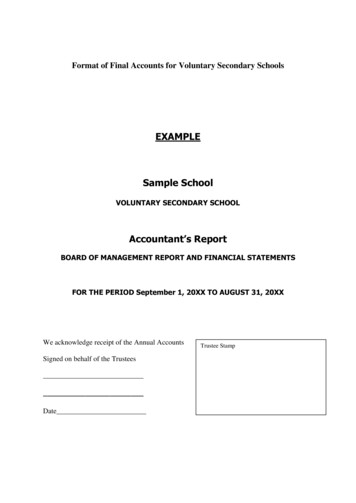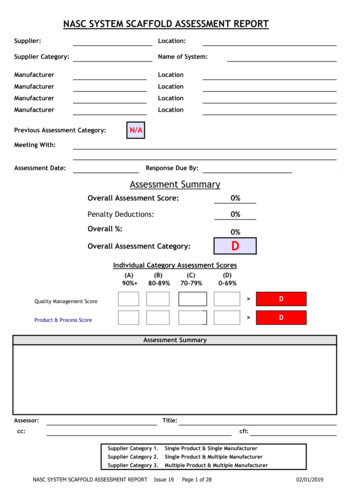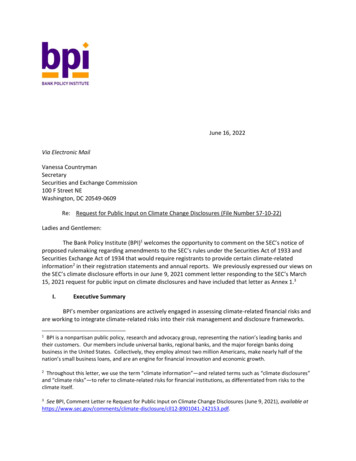
Transcription
BANK POLICY INSTITUTEJune 16, 2022Via Electronic MailVanessa CountrymanSecretarySecurities and Exchange Commission100 F Street NEWashington, DC 20549-0609Re: Request for Public Input on Climate Change Disclosures (File Number S7-10-22)Ladies and Gentlemen:The Bank Policy Institute (BPI)1 welcomes the opportunity to comment on the SEC’s notice ofproposed rulemaking regarding amendments to the SEC’s rules under the Securities Act of 1933 andSecurities Exchange Act of 1934 that would require registrants to provide certain climate-relatedinformation2 in their registration statements and annual reports. We previously expressed our views onthe SEC’s climate disclosure efforts in our June 9, 2021 comment letter responding to the SEC’s March15, 2021 request for public input on climate disclosures and have included that letter as Annex 1.3I.Executive SummaryBPI’s member organizations are actively engaged in assessing climate-related financial risks andare working to integrate climate-related risks into their risk management and disclosure frameworks.1BPI is a nonpartisan public policy, research and advocacy group, representing the nation’s leading banks andtheir customers. Our members include universal banks, regional banks, and the major foreign banks doingbusiness in the United States. Collectively, they employ almost two million Americans, make nearly half of thenation’s small business loans, and are an engine for financial innovation and economic growth.2Throughout this letter, we use the term “climate information”—and related terms such as “climate disclosures”and “climate risks”—to refer to climate-related risks for financial institutions, as differentiated from risks to theclimate itself.3See BPI, Comment Letter re Request for Public Input on Climate Change Disclosures (June 9, 2021), available cll12-8901041-242153.pdf.
Securities and Exchange Commission-2-June 16, 2022Many BPI member banking organizations publish extensive climate-related disclosures, including viatheir websites and through voluntary reports or through reporting required by international regulators.These actions are part of a trend by registrants to increasingly and voluntarily disclose climate-relatedinformation that goes beyond any material climate disclosures already included in registrants’ SEC-filedreports in an effort to be responsive to requests from investors, consumers, employees, andinternational authorities. We expect this trend would continue even absent SEC action on climatedisclosures. For such disclosures to be meaningful to investors, however, they need to be consistentand comparable to each other and to international climate disclosure standards, which the SEC can helpdrive through a more standardized reporting framework. As a result, BPI supports efforts by the SEC topromote consistency, comparability, and reliability of these disclosures, while maintaining the SEC’straditional approach of principles-based, rather than overly detailed, disclosure requirements.We provide recommendations below for how the SEC can better calibrate the final rule toachieve its objectives. The following recommendations cover the priority topics for BPI member banks: The Regulation S-X financial reporting requirements are largely inoperable, will not result inuseful disclosure for investors, and should be removed or, at a minimum, significantlynarrowed. There are a host of practical problems that would make compliance with theproposal’s financial reporting requirements infeasible, and any resulting disclosure wouldnot be useful for investors. At this stage, disclosures of material climate-related financialimpacts should be primarily qualitative and provided in the Management’s Discussion andAnalysis (MD&A) section of Form 10-K filings. If the SEC wishes to consider climate-relatedfinancial reporting in the future (e.g., for “transition activities”), it should go through thestandard Financial Accounting Standards Board (FASB) process to determine how to do so.If the SEC decides to retain a financial reporting requirement, the proposal should benarrowed significantly to only require material quantitative disclosures in aggregate that areeasily observable for defined severe weather events for both the financial impact andexpenditure metrics, given that producing disclosures for transition activities would requiremyriad assumptions and would not result in useful information for investors. The Scope 3 emissions disclosure requirements are overly broad as drafted and should besignificantly narrowed. The proposal’s Scope 3 emissions disclosure requirements—and asparticularly relevant to banking organizations, disclosure of financed emissions underCategory 15 of the Greenhouse Gas (GHG) Protocol—are overly broad. They wouldsignificantly redefine the concept of materiality under the federal securities laws, as setforth in binding Supreme Court precedent. Overly broad Scope 3 emissions disclosurewould not result in consistent, comparable, or reliable disclosure given the significantchallenges around Scope 3 emissions data quality and availability and the continuingevolution of Scope 3 calculation methodologies, and would not result in useful informationfor investors. Many members are already voluntarily providing Scope 3 emissions data,where possible, in their sustainability reports. Rather than redefining the securities lawsand violating long-standing legal and market concepts, the SEC should encourage Scope 3emissions disclosures outside of the SEC reporting documents. Moving in that directionwould encourage more robust climate risk disclosures at an appropriate pace as the qualityand availability of information increases. If the SEC retains the Scope 3 emissions disclosurerequirements, the SEC should significantly narrow the requirements, including by tailoringthem to registrants’ material climate commitments and goals, which have primarily focusedon high-emissions sectors. Furthermore, to the extent the proposed Scope 3 disclosure
Securities and Exchange Commission-3-June 16, 2022requirements are included in any final rule—even if in a narrower form—the SEC shouldprovide for a longer transition period of at least two years from the rule’s final effectivedate. The risk management aspects of the proposal should be modified so that they do not frontrun, and are consistent with, ongoing efforts by the federal banking regulators. Bankingorganizations are subject to federal prudential regulation by the Federal Reserve, the Officeof the Comptroller of the Currency, and the Federal Deposit Insurance Corporation(collectively, the prudential regulators). The prudential regulators have been working bothdomestically and internationally over the past year to develop guidance and expectationsfor banks with regard to risk management, governance, and climate scenario analysis—withconsultations currently outstanding.4 Given the extensive work that is underway by theprudential regulators, any climate change disclosure regime applicable to bankingorganizations should recognize the supervisory objectives and early stage of these effortsand not front-run the prudential process. The proposal’s board and management governance provisions should be modified to be lessprescriptive. The proposal would impose substantive requirements on registrants that arenot appropriate for a disclosure regime. The governance provisions should be revised to beprinciples-based, which would generate more useful disclosure that is tailored toregistrants’ businesses, rather than have the SEC suggest specific governance practices. The proposal’s cost-benefit analysis does not satisfy the SEC’s statutory cost-benefitobligations. The SEC is required to conduct a thorough and rigorous cost-benefit analysis aspart of its rulemaking process.5 Here, the SEC’s analysis falls short, particularly with respectto assessing costs for banking organizations. The SEC largely does not quantify putativebenefits of the proposal, and the benefits that are discussed are highly speculative, whereasthe SEC significantly undercounts costs. The proposal should be revised to permit foreign private issuers (FPIs) to comply using homecountry standards. All FPIs should benefit from a substituted compliance regime, such asapplies to Canadian registrants. To avoid conflicts of law and implementation challenges, the proposal should permitalternative compliance by using international standards. Once the rule is finalized, all4See Basel Committee on Banking Supervision, Consultative Document, Principles for the Effective Managementand Supervision of Climate-Related Financial Risks (Nov. 2021), available athttps://www.bis.org/bcbs/publ/d530.pdf; Office of the Comptroller of the Currency, Principles for Climate-RelatedFinancial Risk Management for Large Banks (Dec. 16, 2021), available at ulletin-2021-62.html; Federal Deposit Insurance Corporation, Statement of Principlesfor Climate-Related Financial Risk Management for Large Financial Institutions, 87 Fed. Reg. 19507 (Apr. 4, 2022);Financial Stability Board, Interim Report, Supervisory and Regulatory Approaches to Climate-Related Risks (Apr. 29,2022), available at .5The statutes require the SEC to “consider, in addition to the protection of investors, whether the action willpromote efficiency, competition, and capital formation.” 15 U.S.C. §§ 77b(b), 78c(f), 80a-2(c). Courts have reliedon this language to evaluate the sufficiency of the SEC’s cost-benefit analysis. See, e.g., Business Roundtable v.SEC, 647 F.3d 1144 (D.C. Cir. 2011).
Securities and Exchange Commission-4-June 16, 2022registrants should have the option of using International Financial Reporting Standards(IFRS) Foundation’s International Sustainability Standards Board (ISSB) as an alternativemeans of compliance. The proposal should not require third-party attestation of Scope 1 and Scope 2 GHGemissions disclosures. In light of the robust controls registrants already have in place overtheir 10-Ks, the benefits of such attestation do not outweigh the costs. The SEC should provide more guidance around GHG emissions verification. We agree withthe SEC’s approach not to mandate the precise GHG emissions verification standardsneeded for a registrant to meet its Regulation S-K obligations. However, to give registrantsgreater certainty, the SEC should provide additional guidance regarding which verificationstandards would be acceptable. Should the SEC retain an attestation requirement, it should confirm that attestation reportsare considered expertized material for purposes of Scope 1 and Scope 2 GHG emissionsdisclosures, and the attestation requirements should be scaled back. Firms acting asunderwriters will be subject to unwarranted due diligence requirements if Scope 1 and 2GHG emissions attestations are not considered to be expertized material for purposes ofliability under Section 11 and Section 12 of the Securities Act of 1933 and Rule 10b-5 underthe Securities Exchange Act of 1934. Similar to other expertized material such as financialstatements, technical reports for mining companies, and reserve reports for oil and gascompanies, the highly technical nature of attestation reports and the assurance proceduresrequired to be conducted by a third party make it unreasonable to expect underwriters tobe responsible for performing the same level of diligence as would be appropriate for nonexpertized material. Although the proposal seems to assume that attestation reports areexpertized, the SEC should modify the proposal to clarify that attestation reports areexpertized material for liability purposes. The SEC should clarify that consolidation of legal entities for GHG emissions disclosures neednot match consolidation for financial reporting. There are many operational challenges thatwould restrict a registrant’s ability to follow the same consolidation treatment for both GHGemissions disclosures and financial reporting. The SEC should recognize these limitationsand clarify that registrants may choose, and disclose, their approach to organizationalboundaries for purposes of computing GHG emissions.The remainder of this letter provides more detail on our recommendations.II.The Regulation S-X financial reporting requirements are largely inoperable, will not resultin useful disclosure for investors, and should be removed or, at a minimum, significantlynarrowed.The Regulation S-X financial disclosure requirements included in the proposal are entirely noveland go far beyond the Taskforce on Climate-related Financial Disclosures (TCFD) framework on whichthe SEC proposal is ostensibly based and beyond any requirements issued by any other country orinternational standard. The proposed Regulation S-X disclosures are also novel within the context of thecurrent U.S. financial reporting framework, in that they would require separate accounting for climaterelated factors—an approach that is uncommon for any other factor. We believe that compliance withthe requirements ranges from very difficult to impossible, and even if the required data could be
Securities and Exchange Commission-5-June 16, 2022produced, it would not provide useful information for investors. We discuss these challenges furtherbelow.A. Information should be in nonfinancial, not financial, disclosures.The SEC should remove the Regulation S-X climate disclosure requirements from the proposal.The SEC’s objective of providing consistent, comparable, reliable, and useful information to investorsabout material climate-related financial impacts would be more effectively achieved through qualitativedisclosure as part of the MD&A discussion of material risks, where financial impacts would be disclosed,if material, under current guidance. Qualitative disclosures in the MD&A would provide investors withinformation about material climate-related impacts together with other discussion of key drivers ofperformance for the periods presented. To the extent the SEC wishes to explore quantitativedisclosures of climate-related factors (e.g., for “transition activities”) and risks in financial statements, itshould go through the customary FASB accounting standards process. For example, the FASB iscurrently performing research on a project to address the accounting for financial instruments withenvironmental, social, and governance (ESG)-linked features and regulatory credits, which potentiallywould include disclosure requirements related to, for example, climate-related targets.Should the SEC decide to retain the Regulation S-X requirements in some form, theserequirements should be limited to quantitative disclosures in aggregate for clearly defined and easilyobservable severe weather events for both the financial impact and expenditure metrics, only to theextent the impact is material under Supreme Court precedent.6B. Banks are not able to disaggregate climate-related financial impacts in any way that wouldresult in meaningful disclosure for investors.The Regulation S-X part of the proposal would also require disclosure of the financial impact ofrisks identified pursuant to the Regulation S-K part of the proposal. The proposal wrongly assumes thatregistrants would be able to tie identified potentially material climate risks in the Regulation S-Kdisclosures to the financial statements in the Regulation S-X disclosures. Banks are not able to lookbackwards to disaggregate the financial impact of any specific risk factor, and disaggregating climaterelated risk would be even more challenging given the nascent and evolving state of climate riskmanagement capabilities and the challenges around modeling a type of risk that is inherently uncertain.Registrants could theoretically compute the financial statement impact of certain types of physicalweather events, although we do not believe it would result in useful information for investors about thefinancial impact of material climate-related risk as a number of variables would not be able to bedisaggregated as to what element of the weather event is climate-related. But computing the financialimpact of transition activities is exceptionally complex, given the myriad variables. Furthermore, it isunclear how a registrant would assign a financial statement line item impact to a particular variable(e.g., how does a change in regulation map onto a financial statement line item).As one alternative to the proposed Regulation S-X requirements, and as suggested inQuestion 61 of the proposal, the SEC could require disclosure regarding discrete, observable weatherevents and natural conditions that have occurred, instead of requiring financial disclosure regarding abroader swath of climate risks. Although such a narrowed scope would still have its implementation6See n.18 below and accompanying text.
Securities and Exchange Commission-6-June 16, 2022challenges, this would be much more workable than the rule as proposed. That said, current researchindicates that such risk may not be material to investors.7The proposal would require banks to implement processes and procedures to disaggregate thefinancial impact of climate-related impacts and expenditures and material climate-related risks (subjectto external audit) and provide disclosure in a footnote to the audited financial statements if the amountexceeds 1% of any relevant line item in the financial statements. This would effectively require banks toduplicate the current ledger and create a mirror image “climate ledger” to create a balance sheet andincome statement for climate-related impacts. This would be needed in order to create an audit trail todetermine whether those impacts are greater than 1% of the reported line item (and therefore need tobe disclosed in a footnote to the financial statements). The cost of conducting this sort of analysis,assuming it could be done, would far outweigh any benefit of such information to investors.We recognize the SEC’s interest in providing investors with greater disclosure of climate-relatedfinancial risk, but banks are not able to disaggregate financial impacts specific to climate-related factorsfrom other factors in any way that would result in meaningful disclosure for investors.8 When severeweather events and policy changes affect a specific industry, a bank would not be able to differentiatethese effects from a myriad of other factors that could be influencing the value of its assets—e.g.,geopolitical risks, COVID-19, general market conditions.We provide below two examples that illustrate why banks are not able to disaggregate thefinancial impact of climate-related factors or risks on financial statement line items:1. Line item: principal transactions revenue. For Fair Value products, the market price willinherently have some element of climate/transition impact embedded. For example, bankswould not be able to determine what the prices of securities would have been absent a severeweather event or transition activity.2. Line item: provision for credit losses. For example, a bank client experiences a decline increditworthiness which could have been the result of a variety of factors, including climaterelated risk; it would not be feasible to disaggregate the provision amount specificallyattributable to those climate-related risks absent the occurrence of a specific, observable event(e.g., a debtor manufacturing facility is destroyed by a severe weather event, resulting in7See Kristian S. Blickle, Sarah N. Hamerling, and Donald P. Morgan, How Bad Are Weather Disasters for Banks?,Federal Reserve Bank of New York Staff Report (Nov. 2021, revised Jan. 2022), available search/staff reports/sr990.pdf.8The Federal Reserve has also acknowledged the difficulties. See Celso Brunetti, Benjamin Dennis, Dylan Gates,Diana Hancock, David Ignell, Elizabeth K. Kiser, Gurubala Katta, Anna Kovner, Richard J. Rosen, and Nicholas K.Tabor, Climate Change and Financial Stability, FEDS Notes (Mar. 19, 2021), available 10319.htm(“In principle, quantifying climate-related risks should be similar to quantifying other financial stability risks. Inpractice, however, climate-related risks face several challenges to measurement beyond those associated withconventional financial system vulnerabilities and potential shocks, and which will require investment to address.These climate-related features impair not only estimation and modeling at the level of the overall economy, butalso the analysis of region-, sector-, asset-, institution-, and investor-level exposures. Investment in dataprocurement, and careful analysis of climate-related data to describe specific economic and financial risks, iscritical to addressing these challenges and producing high-quality research on climate-related outcomes.”).
Securities and Exchange Commission-7-June 16, 2022significant lost sales which directly impacts their ability to repay). This is particularly challengingin the case of transition activities as well. Financial impact as a result of transition activities isalso indirectly transmitted to a bank through the financial impacts on a bank’sclients/borrowers.C. The proposal’s 1% disclosure threshold would result in disclosure of significant amounts ofinformation that is not meaningful to investors.The proposed requirements to disaggregate climate-related impacts will not result inmeaningful disclosure for investors. This is exacerbated by the proposed 1% threshold for disclosure,which would result in significant amounts of information that is both immaterial and does not provideinvestors with any meaningful understanding of material climate-related financial impacts.Having a percentage threshold for disclosure—particularly on an absolute value, line-by-linebasis, whether 1% or higher—would effectively require registrants to create a separate “climate ledger”to track and perform the calculation on a quarterly basis. The would also require a registrant toestablish internal controls to ensure this process operates effectively.9 This is an immense burden torequire for a large amount of nonmaterial information that is likely going to overwhelm and confuseinvestors, without providing them material information.D. The lack of clear definitions exacerbates the proposal’s inoperability.As a further complication, the proposal’s key definitions lack clarity. The requirements—inaddition to being fundamentally inoperable—are vague and ambiguous and would require significanttechnical guidance to interpret as a substantive matter. We note that additional technical guidancewould not resolve the underlying problem with the inability to disaggregate the financial impacts ofspecific factors. Fundamental challenges with this part of the proposal are outlined below. Lack of clarity in the definition of “severe weather event.” It is not clear whether the SEC isasking for disclosure regarding the full impact of a weather event or the portion attributableto climate change, assuming the latter could even be calculated in a disaggregated manner. Lack of clarity regarding what registrants are required to track and how they should tracktransition activities, as the SEC is effectively asking registrants to disaggregate climatetransition risk in every financial statement line item. The proposal would requiremanagement to make estimates and assumptions to allocate what portion of each line itemis or is not attributable to climate transition risk, which would be extremely difficult if notimpossible for financial instruments. Lack of clarity as to how a registrant would identify “transition activities” and whether theregistrant’s intent plays a role in whether to classify an activity as a “transition activity.” Forexample, suppose a registrant’s gas-powered vehicle fleet is at the end of its useful life andthe registrant replaces it with an electric vehicle fleet (or even a lower-emission, gaspowered vehicle fleet), or suppose a registrant engages in a building efficiency upgrade. Arethese “transition activities” because they reflect a change to a greener outcome, or does themotivation for the change—which could include a legislative or regulatory requirement or9See Proposal, 17 C.F.R. § 210.14-02(b).
Securities and Exchange Commission-8-June 16, 2022considerations like cost savings—play a role in determining whether they are “transitionactivities”? The proposal does not provide an answer to this question and it is unclear howa judgment would be anything other than arbitrary, in which case we question whether theinformation is useful to investors. Lack of clarity as to how a registrant would identify the financial impact of a “transitionactivity” like a new law or regulation, because it is not clear how to disaggregate that impactfrom other variables. Although it may be possible for a registrant to forecast the impact offuture law or regulation, it is impossible on a backward-looking basis to disaggregate itsimpact. This is a problem because the proposal would require registrants to include theRegulation S-X climate financial impact of both current and historical financial data onclimate-related impacts.10 We note that registrants already disclose a sectoral breakdownof credit exposure, so investors can already see, for example, the oil and gas sector brokenout. However, it is not clear how registrants could compute a backward-looking, regulatorydriven impact; it would require a multitude of assumptions as a “what-if” analysis, resultingin disclosure that would be wholly speculative and therefore misleading for investors. Lack of clarity as to how registrants would include in their disclosures the financial impact oflost revenue due to transition activities.11 As drafted, the proposal implies that it wouldinclude deals that did not come to fruition and would require assessing opportunity coststhat are not currently in any financial reporting disclosures. Registrants do not and cannothave this information without making significant assumptions and rough estimates, resultingin this information being speculative and misleading for investors. Lack of clarity as to how an external audit could be completed for registrants regarding thisinformation, exacerbating the difficulty with tracking and disclosing transition activities. Therequired disclosures in the proposal are not verifiable because they are not based onunderlying historical factual transactions. Instead, they are based on managementestimates and judgments performing “what-if” analysis and computing opportunity cost.Historically, this kind of information is presented in the MD&A, if at all, and does not requirethe financial statements auditing processes.E. Several aspects of the Regulation S-X calculations are particularly inoperable for bankingorganizations.Elements of the Regulation S-X part of the proposal pose unique burdens on the banking sector.For example, a significant portion of the balance sheet for banks is composed of trading assets andinvestments that are generally measured at fair value, often based on quoted prices in active markets orother observable inputs, and loans and certain debt securities held at amortized cost but assessed forexpected credit losses (i.e., under the current expected credit loss (CECL) framework, which is not aloan-level estimation approach). In this banking context, it would not be feasible to track and provideline-by-line climate-related impacts, which would require developing a process at the position orinstrument level to disaggregate the impacts of climate versus other entity- or market-related economicfactors when assessing changes in fair value or determining credit loss provisioning. Fair value of10See Proposal, 17 C.F.R. § 210.14-01(d).11See Proposal, 17 C.F.R. § 210.14-02(d).
Securities and Exchange Commission-9-June 16, 2022financial instruments fluctuates daily based on the many drivers of market prices. It would not befeasible to identify what portion of changes in the value of these instruments is directly related to apotential physical- or transition-risk event.The lack of detail on “transition activities” is particularly problematic for the banking sector,because climate-related risks are indirectly transmitted to banking organizations through theperformance of the companies to which banking organizations lend. Consider the following examples: A banking organization might lend to an oil company that sees an increase in its strandedassets following new regulations. That could cause the creditworthiness of the oil companyto decline and result in nonperforming assets or write-offs for the banking organization.However, the creditworthiness of an oil company depends on many different factors—forexample, geopolitics, consumer demand, innovation, competition. None of these factorsare directly observable in the market, thus hampering the ability to verify disclosure. Itwould be infeasible to disaggregate whether climate or other factors led to the creditdowngrade and the concomitant effects on the banking organization’s financials. It wouldalso not be useful for investors, for whom the relevant statistics are the net charge-offs andnonperforming assets, not what might lead to those results. This more relevant financialinformation is already disclosed in the 10-K at a sectoral level. It is unclear how bankingorganizations can disaggregate impact without including so many assumptions that theinformation provided would be unhelpful or potentially misleading to an investor. A banking organization might make trading gains on its balance sheet from a long position inan electric vehicle manufacturer after a policy announcement to phase out fossil fuel engineuse. Similar to the creditworthiness of oil companies, aut
The Bank Policy Institute (BPI)1 welcomes the opportunity to comment on the SE's notice of proposed rulemaking regarding amendments to the SE's rules under the Securities Act of 1933 and Securities Exchange Act of 1934 that would require registrants to provide certain climate-related
